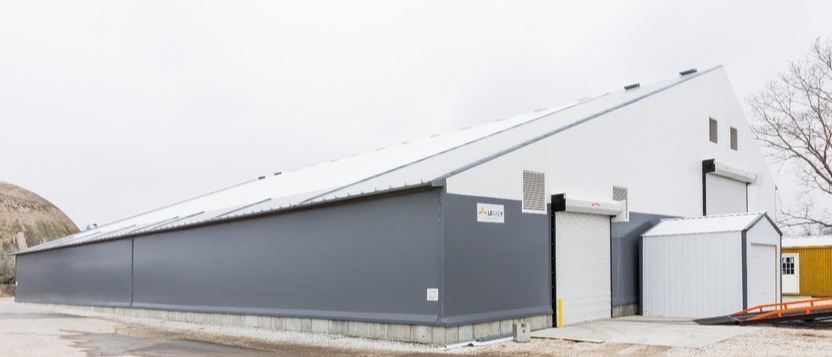Speed and Quality: The Role of Hybrid Building Materials

We’ve all heard the expression, “It can be fast, or it can be good, but it can’t be both.” In commercial construction, this outdated notion no longer applies, especially when implementing cost-effective design solutions.
Many people involved in commercial design and construction now use building information modeling (BIM) to enhance project efficiency. Creating greater process value is essential for productivity and profitability, but the materials you choose also have a major impact.
Innovative technologies and strategic material applications make hybrid buildings a compelling alternative to conventional construction methods. Hybrid material use can help contractors win more bids by dramatically reducing construction timelines without sacrificing quality.
Materials That Encourage Speed and Quality
Advanced building materials provide the durability that ensures a long lifespan.
- Robust steel I-beam framework to help endure heavy rain or snow, extreme temperatures, or harsh events
- Superior EpoxxiShield™ coating protection to resist corrosion and allow for long, clear spans without support columns
- Resilient ExxoTec™ fabric cladding that seamlessly attaches to the framework in panels that can be replaced individually
- Minimal maintenance requirements over time
Strong, flexible hybrid buildings are designed for maximum performance and efficient installation. They withstand extreme weather, including hurricanes, while meeting rigorous industry standards.
However, material selection is only part of the equation. Contractors also benefit from having fewer subcontractors to manage. Partnering with a specialized fabric provider amplifies the advantages of using BIM to further increase project confidence.
Building information modeling is popular because it facilitates communication. Everyone has access to all the information they need as they need it. 3D visualization shows how the structure will look and function, inside and out, so it’s easy to correct or alter the design. That optimizes engineering in construction and also the steps that follow to complete the process.
Fast Installation Methods
One of the most significant advantages of modern hybrid and fabric construction lies in how quickly the building envelope can be installed. Traditional metal cladding systems require thousands of fasteners, and installing them properly demands considerable time and skilled labor. A typical metal roof installation can take weeks to complete, extending the critical path of your construction schedule.
Advanced fabric cladding systems work differently. Legacy's proprietary attachment system utilizes extruded aluminum rails without thousands of fasteners. In fact, ExxoTec™ fabric is 100% attached without fasteners, allowing a small, specialized crew to install large roof systems in just a few days rather than weeks.
This time savings creates a cascade effect throughout the project timeline. The sooner all remaining trades can work under a dry, enclosed roof, the faster the overall project can be completed. Weather delays become less of a concern, and interior work can proceed on schedule regardless of external conditions.
Speed Without Compromise
The installation speed of these advanced systems doesn't come at the expense of quality. Fabric buildings installed border to border and coast-to-coast have withstood every wind condition, from prairie storms to coastal hurricanes. The flexible yet durable fabric envelope actually performs better than rigid materials in extreme weather conditions, moving with wind forces rather than fighting them.
This performance record demonstrates that faster installation methods can actually result in superior long-term durability when engineered properly.
Close Collaboration
At Legacy, we coordinate with all parties in a construction project—architects, designers, engineers, owners, and contractors—to ensure each project’s design will achieve desired physical and functional objectives. That minimizes risk of costly change orders and delays as we move to the manufacturing phase (also entirely in-house) and, finally, to installation.
Customized Design-Build
Each Legacy hybrid structure is individually crafted from concept to completion. This approach accommodates unlimited construction possibilities and precise specifications—including distinctive architectural features and specialized requirements, even when facing significant constraints like restricted space.
Professional installation
The effectiveness of any advanced building system depends on proper installation. Our in-house installation teams are factory-trained specifically for hybrid structures, enabling them to work efficiently and accurately to get buildings up and operational. Their specialized expertise ensures that the speed advantages of the system are fully realized without compromising installation quality.
End to end, hybrid buildings can be completed in significantly less time than other types of structures while maintaining the structural integrity and performance characteristics that ensure decades of reliable service.
Finding the Right Balance of Speed and Quality
The bottom line for every commercial contractor is customer satisfaction, now and long term. Modern hybrid construction methods prove that the old trade-off between speed and quality is obsolete. When advanced materials are combined with innovative installation techniques and experienced teams, contractors can deliver superior results in less time.
Find out more about how hybrid and tension fabric buildings can improve your projects and please your clients with proven quality and a shorter time to completion.
Hybrid Construction FAQs: Speed, Quality, and Modern Building Solutions
Yes. Hybrid steel and fabric buildings are engineered to install quickly without sacrificing durability. They prove the old trade-off between speed and quality in commercial construction is no longer true.
BIM facilitates clear communication, 3D visualization, and real-time design adjustments. This helps contractors reduce errors, avoid costly changes, and deliver projects faster and more confidently.
Hybrid systems use a robust steel I-beam frame, EpoxxiShield™ corrosion-resistant coating, and ExxoTec™ fabric cladding. These materials are durable, weather-resistant, and allow faster installation compared to metal panels that require thousands of fasteners.
Unlike traditional metal cladding, ExxoTec™ fabric attaches without thousands of fasteners. Large roof systems can be installed by small crews in days instead of weeks, accelerating the overall project timeline.
Subscribe to our Blog
Recent Posts
- 5 Factors Every Project Owner Should Consider Before Approving Building Materials
- The 20-Year View: How Material Choices Impact Long-Term Operational Costs
- Climate Resilience in Commercial Construction: Why Traditional Methods May Not Be Enough
- Speed and Quality: The Role of Hybrid Building Materials
- Beyond the Bleachers: Designing Visually Striking Sports Facilities
